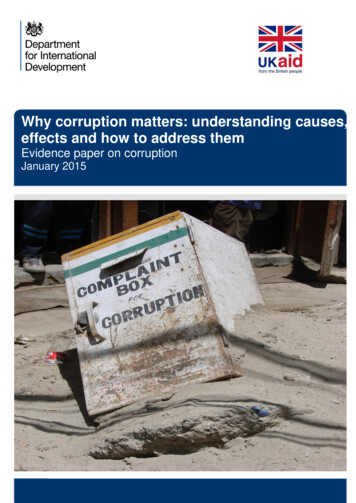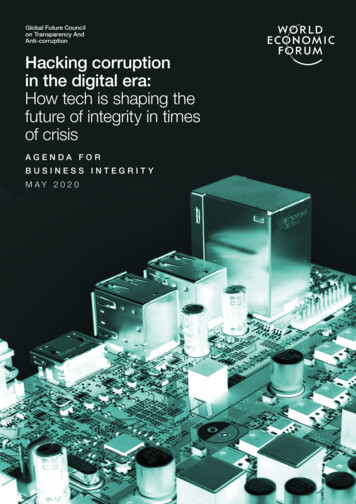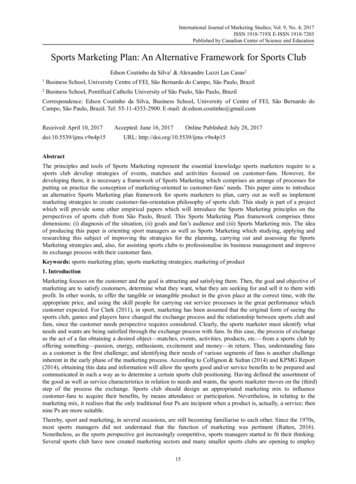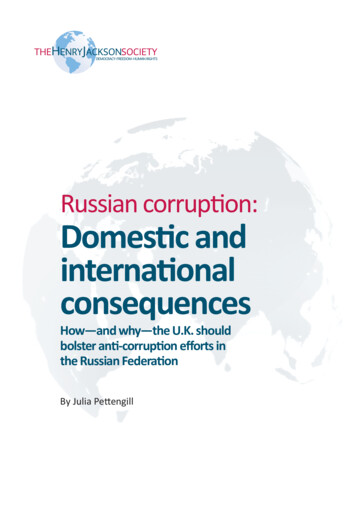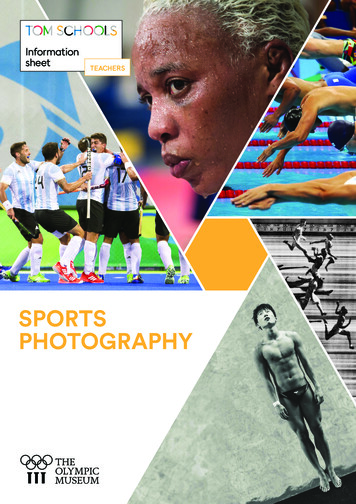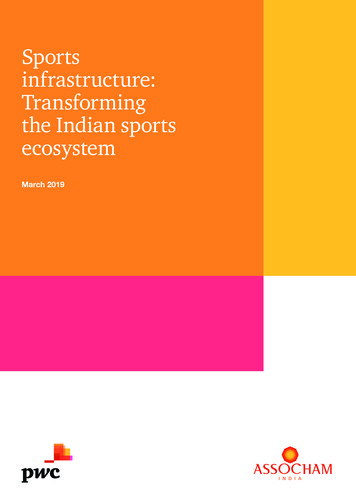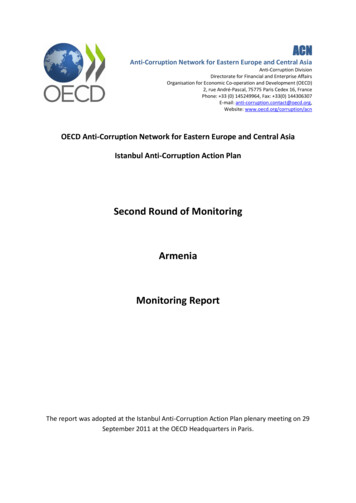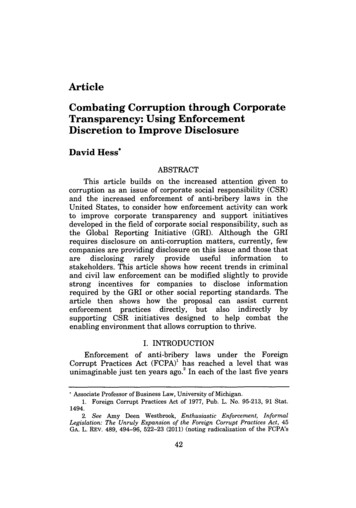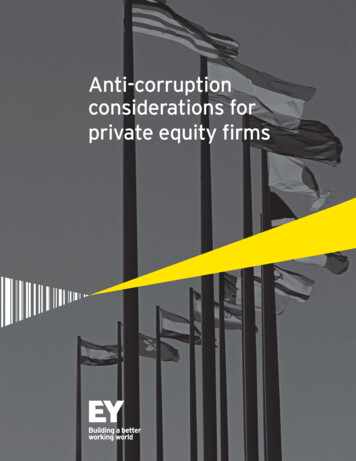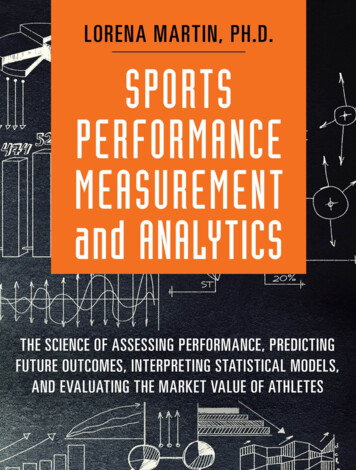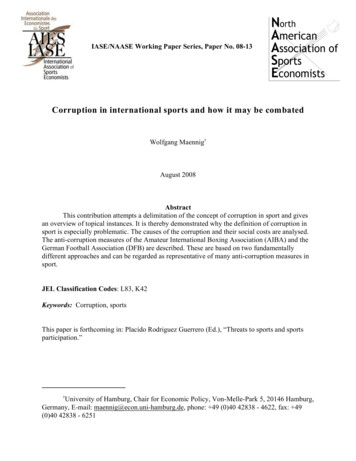
Transcription
IASE/NAASE Working Paper Series, Paper No. 08-13Corruption in international sports and how it may be combatedWolfgang Maennig†August 2008AbstractThis contribution attempts a delimitation of the concept of corruption in sport and givesan overview of topical instances. It is thereby demonstrated why the definition of corruption insport is especially problematic. The causes of the corruption and their social costs are analysed.The anti-corruption measures of the Amateur International Boxing Association (AIBA) and theGerman Football Association (DFB) are described. These are based on two fundamentallydifferent approaches and can be regarded as representative of many anti-corruption measures insport.JEL Classification Codes: L83, K42Keywords: Corruption, sportsThis paper is forthcoming in: Placido Rodriguez Guerrero (Ed.), “Threats to sports and sportsparticipation.”†University of Hamburg, Chair for Economic Policy, Von-Melle-Park 5, 20146 Hamburg,Germany, E-mail: maennig@econ.uni-hamburg.de, phone: 49 (0)40 42838 - 4622, fax: 49(0)40 42838 - 6251
Corruption in international sportsand how it may be combattedFirst of all, most accusations of corruption in sport should not be taken too seriously. Whenathletes lose, they tend to look everywhere else for the blame rather than at themselves.Dishonest wheelings and dealings of their opponents, such as corruption and doping, may alsobe readily cited as an excuse. When fans see their team lose, the accusation of rigging alwaysquickly arises.From there, especially in sport, we should speak of “facts” only, when there are legallybinding decisions – and not reports cases in which there are merely suspicious circumstances.Nevertheless, from the economic viewpoint, there is an aspect that favours dealing explicitlywith the suspicious circumstances: the actual corruption in a society is positively dependentupon the mechanism of “self-fulfilling prophecies” from the generally perceived or feltcorruption. A perception of widespread corruption lowers one’s own moral bounds. In thisrespect, the following remarks should also apply in cases in which there are no legally bindingdecisions but merely suspicious circumstances.In the following, Section 1 attempts a delimitation of the concept of corruption in sport andgives an overview of topical instances. It is thereby demonstrated why the disassociation ofcorruption in sport is especially problematic. In Section 2, the causes of the corruption andtheir social costs are analysed. In Section 3, the anti-corruption measures of the AmateurInternational Boxing Association (AIBA) and the German Football Association (DFB) aredescribed. These are based on two fundamentally different approaches and can be regarded asrepresentative of many anti-corruption measures in sport. Section 4 provides a summing-upand outlines to what extent the typical way in which measures are taken in sport may beexpanded through efficient measures from an economic viewpoint.1Forms, tendencies and the extent of corruption in modern sportsIn the following discussion corruption in sport is understood as-behaviour by athletes who refrain from achieving the levels of performance normallyrequired in the sport in question to win the competition and instead intentionallypermit others to win, or
-behaviour by sporting officials who consciously perform their allocated tasks in amanner at variance with the objectives and moral values of the relevant club,association, competitive sports in general and/or society at large,because they receive or expect pecuniary or non-pecuniary advantage1 for themselves (or, incase the person in question is acting as an agent: for a principal, e.g. acquaintances, relativesand/or associated sports institutions) from the person favoured by the action (or theiracquaintances, relatives and/or associated sports institutions).2Having defined corruption in sport, it has to be admitted that it is nothing new. The firstdocumented case of corruption in international sports is attributed to the athlete Eupolos ofThessalia who successfully bribed three of his competitors in the fist combat tournament atthe Olympic Games of 388 B.C., among them the reigning Olympic champion Phormion ofHalikarnassos.3 There are also records of an early case of corruption in sporting managementand administration. In 12 B.C. Damonikos of Elis, father of the Olympic wrestler Polyktor,attempted to bribe Sosandors, in order for him to persuade his son of the same name toconcede victory in the Olympic wrestling competition to Polyktor. In sum however, a merehandful of cases of corruption in the ancient Olympic Games, held over a period of about athousand years, are documented.4 Nevertheless, according to the account supplied byPhilostratos, corruption seemed to be quite widespread in the sporting world of that time, atleast outside of the ancient Olympics (Decker 1995, 152).Maennig (2005) offers an overview of the most important documented cases of or attempts atcorruption in modern sport of the 20st century, with the majority of corruption cases allocatedinto two distinct categories. Table 1 enumerates some of the most prominent cases ofcorruption (attempts) since 2005.Corruption attacks in international sports relate to the exertion of a delinquent influence onthe one hand over1In connection with the IOC scandal the differentiation between bribes based on reciprocity and gifts is animportant one. The differentiation is problematic, nonetheless, cf. Tanzi (1998, 9).2For attempts at alternative definitions cf. Theobald (1990) and Bardhan (1997, 1321) on the remainingdifficulties of delimitation.3According to the rules of the Olympics of that period, the title of Olympic champion could not be taken awayonce awarded. Eupolos’s name remained on the official list of Olympic victors, cf. Weeber (1991, 118).4Cf. for a description of the cases of corruption in the classical Olympic Games, as well as for references to theprimary literature, Jüthner (1965), p. 94 and 188, Drees (1967), p. 58 et seq, 155, 189, Bengston (1971),p. 80 and 84, Weiler (1985/86 and 1989), Weeber (1991), p. 59 et seq. and 115 as well as Decker(1995), p. 150 et seq. My thanks to Manfred Lämmer for the relevant references to the literature.
-management decisions by sporting bodies and sports officials (referred to henceforthas “management corruption”), and in particular regarding-host venues for important competitions,-allocation of rights (e.g. for televised transmission),-nomination for positions (including honorary positions)-commissioning constructions works for sports arenas and other venues,as well as on the other hand over-competition results (“competition corruption”), whereby the provider and the recipientof the bribes can be-athletes only-sporting officials and other non-athletes only (sometimes without theknowledge of the athletes involved)-athletes and officials.We can however usefully relativise the definition, categorisation and determination of theactual extent of corruption.-A clear definition of corruption is difficult in any case, even without the sportingconnection.5 The concept of corruption is interpreted differently from nation to nation(and from continent to continent); various types and forms exist, which need to beanalysed in different ways.6 The case of the Tour de France represents a particularly5Lowenstein (1985) attempts a delimitation with: “.the crime of bribery is the core of a series of concentriccircles representing the degrees of impropriety in official behaviour”. Cf. also Ruff (1977) on thedifficulty of an unambiguous legal definition. Paragraphs 331 to 337 of the German Criminal Codethreaten public servants and judges with legal penalties if they indulge in “ the acceptance of materialadvantage” (in the performance of their duty), “corruptibility” (accepting bribes for dereliction ofduties), “granting of material advantage” and “bribery” (the relevant active processes) . The penal codesof other nations are similar in this respect. Other forms of corruption are rarely penalized.6Cf. Bac (1998) and Tanzi (1998), p.9 et seq.
Table 1a: Corruption – (suspicious) facts / Soccer matches2008Poland28 clubs suspicious to be involved corruption. Minister of Sportdemands retirement of board of directors of polish footballfederation. Second division coach Darius Wdowczyk arrested30.000 offer for match manipulation received by namibiannational team players2008Africa-Cup2007Great Britain: team manager and CEO of FC Portsmouth (1st division) arrested2007PolandMinister and federation controllers arrested2007EuropeUEFA investigates on 15 cases of manipulated matches2007?China:„no non-manipulated soccer ligue match“?Great Britain bribes from player s agents to coachesuntil 2006ItalyManipulations at 8 out of 20 clubs in first divisonuntil 2006Serbia-M.:approx. half of all "Superliga"-matches suspicious to havebeen manipulateduntil 2006Great Britain 3 Premier Ligue clubs suspicious to have manipulated matchesuntil 2005/6Germany/Austria2005Belg., Finnl. Chinese Zheyun Ye systematically manipulates clubs toFrance, NL maximise betting income2005Franceplayers of FC Metz recieve offer for manipulationuntil 2005BrasilienFIFA-referee Periera de Carvalho recieves up to 5550 permanipulated matchuntil 2005Germany3 croatian wagerer bribe referees, players and functioneers2004/05PolandManipulations of several matches.2004/05TurkeyNational team player Karadeniz manipulates several matches2004Russis/ Lettl.: Allegations against russ. Soccer federationuntil 2004ItalyFC Genua buys victory against AC Venediguntil 2004Portugal:150 Persons from 10 Clubs of 1., 2. And 3. Ligue manipulateuntil 2004South Africa 34 of the 40 best qualified referees manipulate first divisionuntil 2004Tch. Rep:New allegations in german second division and against SturmGrazReferees manipulate in charge of 14 out of 16 first divisionclubs
Table 1b: Corruption – (suspicious) facts / outside of soccerOfficial positions: Until 2003, South Korea: sale of NOC memberships Until 2006: WTF-officer Yoo sales „international referee certificates“ for 50 Mio.WonMembership to National teams Equestrain sportAgencies New Soccer players agency in Germany to fight corruptionLocation of federations: 2006, Chungwon Choue, President WTF rents his mother s estate as WTF domicilefor 700.000 p.aLocation of competitions: 2004: succesful orchestration of bribery for London 2012 against IOC-men mberSlawkow 2005: Blair s talks with some 40 IOC-Officials re London 2012Construction of sport facilities: 2002/3: Allianz-Arena München Hockenheim-Ring Düsseldorfer StadionTV-transmission: Attorney asks for imprisonment for up to 4 ½ years for ISSM officials who bribedinternational sport officials 2003-5: MDR / Techem Dt. Sporthilfe Until 2004: HR / several german federationsPromotional rights: Until 2004: Formula One/ Infineon/ BF ConsultingManipulations outside of soccerCycling:o 100.000 for etape victory at Tour de Franceo Lemond sollte für Verzicht auf Angriff auf Hinault 1 Mio bekommen2007: Bet scandal in NBA 2002-2004: Galopprennen in GB Schach, Deutschland/ Russland 2004 Tennis, worldwide 5 italian Tennis-Profis baned and punished with fines because of betting
On permanent basis: National chinese Games: Judo, Taekwon-do, Boxing, RhythmicGymnastics Boxing, Olympic Games 2004: Thailand Badminton, Olympic Champion 2004 Zhang Ning owes her medal to a team internalarrangement. Similar practices in table-tennisOther Did WTF Vize President Indrapana envelope with money?
clear example of the way in which the definition of a particular behaviour as“corruption” depends on the rules of the association or the attitudes of society. Incontrast to the beginning of the 20st century, nowadays for a team member to race a legof the tour “for the captain” of the team is considered perfectly normal, generallyacknowledged and in conformity with the rules. In sporting events other than cycleracing, behaviour of this kind has yet to be accepted by society. An example of this wasthe “team order”7 in the Ferrari Formula 1 team at the Austrian Grand Prix of 2002,when Rubens Barrichello let his team-mate Michael Schumacher overtake him justbefore the finishing line.In addition the partially accurate accusations that the decision to host the 2006 FootballWorld Cup in Germany was “helped along” via the arrangement of financially lucrativefriendly games between FC Bayern Munich and teams from Thailand, Tunisia, Trinidadand Malta also serves to highlight the problems in differentiating between“internationally acceptable”8 gestures of friendship and gifts on the one hand andcorruption on the other.The accusation directed towards the world boxing associations and their athletes andofficials, that places in the world rankings have been sold and/or that title fights withnon-listed athletes have been arranged in exchange for bribes, is also of significance inconnection with the definition of the term corruption. If such world boxing associationsare regarded as “normal” sporting associations, whose main concern is to systematicallyattain a list of the best athletes via competition results, then the behaviour in questionshould clearly be seen as corruption. If by contrast such associations are regarded asbusiness enterprises that maximize their own incomes and those of their members by,amongst other things, being paid to organise sporting events with (television) spectatorsand heavily-sponsored athletes at suitable venues on the basis of “rankings”, then theabove-mentioned payments could also be regarded as a normal form of income. Thisapplies particularly when the objectives and behaviour of this kind of association arepublic knowledge.97“Team orders” can be related to corruption is as much as by adhering to them, an athlete refrains fromachieving a better result in order to retain his or her well-paid place in the team.8On fighting off allegations of corruption by Franz Beckenbauer, President of the O.C. of the 2006 World Cupand his vice-president of the time Fedor Radman cf. N.N. (2003c).9Anyone interested in the sport can and indeed must be aware of such behaviour; cf. Riess (1984, particularlypages 349 onwards), Graham (1999) and N.N. (2004a).
-As far as the categories of corruption on sport are concerned, two tendencies areobvious. On the one hand, at least within the cases of competition corruption that havecome to light, competition judges and other officials are increasingly becoming involvedin corruption, whilst, in contrast to previous eras, athletes and trainers are directlyinvolved less frequently. On the other hand a tendency towards an increased number ofcases of management corruption in sport can also be observed (see Maennig 2005 formore details).Within the field of management corruption there is also a diversification into new areasof activity. Early in the year 2004, for example, the South Korean official Kim UnYong, among his many official posts also Vice President of the International OlympicCommittee, became the subject of investigations due to allegations of having received atotal of some 333,000 from other officials, who in return were allegedly accepted asmembers of the National Olympic Committee of South Korea. Since then, Kim has beensentenced to two and a half years imprisonment.In connection with the construction of the new football stadium for Bayern Munich andTSV Munich 1860, currently under way at the time of writing, a number of members ofthe club’s management team – now dismissed - are alleged to have received bonuses ofsome 2.8 million for passing on inside information to the Austrian construction firmAlpine-Mayreder Bau Salzburg GmbH, enabling it to make a successful tender for theconstruction works worth over 280 million. Alpine-Mayreder has meanwhileconfirmed that on the successful conclusion of the deal it was prepared to pay “anarrangement fee” to those “who drew the attention of the management to this prestigiousproject and who put us in touch with a highly creative team of architects”, yet considersthis behaviour to be “neither legally problematic nor dishonest”.Furthermore, in connection with the allocation of the rights for the TV marketing of the2002 and 2006 football World Cup Championships, allegations have also surfacedconcerning the payment of bribes to association officials (Hartmann, Jeske, Weinreich2004, 45). So far however these allegations have had no legal consequences.It should also be mentioned that “modern public relations” mean that sports clubs andassociations tend to treat journalists in a way that, at the very least, brings with it thedanger of corruptive effects. Thus for example selected journalists, whose subsequentarticles are closely scrutinized, receive flights in the private jets of sponsoring
companies to games, as well as generous food and lodging at the sponsors’ expense.10So-called PR advertisements, i.e. paid articles, which at first glance seemindistinguishable (or at least hard to distinguish) in terms both of appearance andcontent from other normal articles, are not unusual, particularly in connection withlarge-scale sporting events. In the case of some major events such as the Biathlon WorldChampionships, the main sponsor has in the past paid for (overpriced) advertising on thesports pages to ensure “adequate” coverage of the event. However this is a phenomenonthat not only affects sport but also industry, etc., and which for this reason should bedealt with at greater length in an analysis of corruption in the media.11,12The cases discussed here, in which corruption in sports is used to attain certain positions(honorary or otherwise), influence the allocation of television or other rights, or acquireconstruction contracts, represent “innovations”, which until recently were consideredunthinkable. It seems possible that all the areas of activity relating to sport will in futurebe affected by corruption, in as much as this has not happened already. For this reasonalone the categorisation of corruption given above can have no claim to completeness.-As for the extent of corruption in sport, we must assume that the known cases merelyrepresent the tip of the iceberg. In industrialised countries such as Germany, 5% at mostof corruption cases are brought to light (Bannenberg and Schaupensteiner, 2004). Thisfigure, which is specific to corruption, corresponds well with the estimation that thelevel of undiscovered cases of crimes in the economy as a whole can (implicitly) be ashigh as 96% in some areas13 and is thus estimated to be higher than for other types of10Not only in sport however is the special treatment of journalists a common practice. Hotels and automobilemanufacturers for example often offer special conditions. In conversation with Hansjörg Elshorst, theChair of the German Chapter of Transparency International and Stanislas Cutzach, Officer, GovernanceStructures, my conversation partners were of the opinion that these practices, which are also widespreadin Germany, cannot be regarded as corruption as long as the discounts are granted to all journalistswithout regard to the contents of their publications.11A similar case can be seen in the malpractice in Brazilian football from the end of the 1990s until the year2001 (Kfouri, 2001). This involved players receiving passports with falsified details on age andnationality, in order to obviate international football regulations. Strictly speaking, these represent casesof fraud in the field of sports. Corruption may have occurred among the passport authorities, if staffmembers made the changes intentionally and in return for favours.12In the context of sports, the media and corruption it is also worth taking note of the investigations currentlyunderway at the “Hessischer Rundfunk” broadcasting company in Germany, where accusation havebeen made against the former head of sports coverage in connection with his over-zealous use of thesystem of co-financing. This system, which is not unusual in sports coverage, involves sponsors forexample, or the event organisers themselves, making payments to the television companies in order toensure television coverage. In this case, sponsors who were clients of the agency belonging to the headof sports’ wife, are also alleged to have received preferential coverage in sports reports, cf. N.N. (2007).13Cf. N.N. (2003b). The figures for Germany given by Rügemer (1996) lead us to assume a high level ofundiscovered cases of general corruption.
crime.14 Assuming that the level of undiscovered cases prevalent internationally and insport are comparable, this would imply that the actual extent of corruption in sport isgreater than reported. This assumption would seem reasonable particularly becausethose continents or sub-continents that are regarded in the discussion on corruption asbeing particularly affected by the phenomenon, i.e. Africa, South America15 and Asia,hardly appear in reports on corruption in sports.Nevertheless this should not be interpreted to mean that the problem of corruption insport is a particularly great one, going beyond the dimensions of corruption in otherareas of human endeavour. Rather, and in spite of all problems of quantification (Tanzi,1998) in the ascertainment of the extent of non-sporting corruption, even for relativelytrustworthy countries, the opinion is prevalent that the hypothesis of corruption as anexception no longer holds.16 The strategies for combating corruption, initially at nationallevel since the end of the Seventies17 and the international measures18 of recent yearshave not been sufficient to stem the tide.19 In addition it should also be noted that thesums paid in bribes in sport seem to be relatively lower than in other areas, wheremeanwhile a level of 30% of the value of the contract to be acquired has been reached(Müller, 2002, 492 and 495). Finally, in the public opinion (at least in Germany), aspolitics, business and administration (see Fig. 1).14The figures for criminal charges (and hence the level of crimes registered) are, according to the relevantestimates, 4 – 6% for shoplifting, just under 50% for robbery and related crimes and a mere 10% forrape and sexual assault, cf. Pfeiffer, Brettfeld and Delzer (1997, p. 1 et seq.)15For a description of the problematic conditions in South American football, where it is sometimes difficult todifferentiate between corruption, systematic distortion of competition, blackmail and fraud, cf. Dukeand Corlley (2001).16Cf. for example on corruption in Germany Rügemer (1996, 328-331). For an overview on the basis of variousinternationally comparative indices of corruption cf. Bardhan (1997, 1343 et seq.) as well as Ades andTella (1999, 986) for further indices. Cf. Tanzi (1998) for a discussion of the problems ofquantification.17The most important measures in this respect were the 1977 Foreign Corrupt Practices Act passed by the USCongress (cf. Sporkin, 1998) and which makes bribery by US firms abroad a punishable act (whichhowever was watered down again in 1988, cf. Bardhan, 1997, 1337) as well as the OECD’s 1994resolution on “Recommendations on corruption in international commerce” (e.g. International Chamberof Commerce/ Deutsche Gruppe, 1998). For an overview of the international measures cf. Mills (1999)as well as OECD (1999).18Cf. Brademas and Heimann (1998) as well as the International Chamber of Commerce’s Code of Conduct(International Chamber of Commerce/ Deutsche Gruppe, 2000).19For an historic overview of corruption cf. Noonan (1984). On the need for further action in the future cf.Kaufmann (1998).
In view of the many sporting events that take place every day throughout the world, thenumber of proven cases of corruption in sport can be put into perspective, even if theconsiderable percentage of unknown cases are taken into account. By the way: even theextent of corruption at the IOC discovered in the late Nineties can be relativised.Following intensive internal investigations, just under 10% of the members of the IOCwere either cautioned or punished (within the space of one year). The overwhelmingmajority of the approximately 100 members behaved correctly. To round off the pictureit should also be said that the charges brought by the US Department of Justice againstthe former heads of the Salt Lake City bids committee, Tom Welch and Dave Johnson,were dismissed by a Federal Court in Utah. The subsequent appeal led to a “first class”acquittal for Welch and Johnson. Summing up, Judge Sam said that: “.a reasonablejury could not find beyond a reasonable doubt that either defendant Welch or defendantJohnson had the required intent to promote, manage, establish, carry on, or facilitate anyunlawful activity. Moreover, there is insufficient evidence for a reasonable jury to findthat these defendants violated elements of Utah’s commercial bribery statute.” (N.N.2003). In the most famous case of corruption in sport, was there no case to answer afterall?Fig. 1: Corruption in sport of subordinate meaning?Source: Frankfurter Allgemeine Sonntagszeitung, may 21st, 2006-There is no proof that corruption in sports has increased in frequency over recent years.It is equally possible that merely the level of public awareness for the subject has
increased. Even if the economic analysis of corruption has indeed revealed factors thatcould have led to an increase in corruption over the last decades (Maennig 2002), weshould also take into account the fact that the improvements in archiving andinternational communications technologies during the same period mean thatinformation on corruption in sport is also more readily available. In any case, no clearempirical evidence for the thesis of increased corruption in sport has been produced sofar.20In connection with the subject of “developmental trends in corruption in sport” or thatof the “unreported cases”, both the 1988 boxing scandal and the above mentioned(alleged?) IOC scandal in the Nineties are of interest. The boxing scandal wasdocumented by the State Security Service (Stasi) of the former East Germany, but onlycame to light when the documents were made accessible to the public after the demiseof the East German state. Also, as far as the scandal around the 2002 Winter Olympics isconcerned, accounts suggest that the US Olympic Application Committee was neitherthe first, nor the only Olympic body to be involved in such activities. The problematicbehaviour of certain IOC members had started to become public knowledge by 1991 atthe latest, when applications were under way to host the 2000 Olympics and dossiersbegan to surface concerning the alleged proclivities and wishes of IOC members.21-It is evident that in comparison to the advantages or utility transfer achieved by thecorrupt behaviour, the actual level in money terms of the bribes used to achieve theseends is relatively low. This corresponds to the usual observations on corruption (Tullock1980; 1990) and refutes earlier theoretical works on “rent-seeking” (e.g. Krueger 1974),which assumed, that via a process of competition the rents were completely transferredto payment of bribes. Clearly there exist entry barriers , transaction costs, risk appraisalsand coordination problems in the “rent-seeking” sector which prevent the full uptake ofthe rents by corrupt officials (Rasmusen/Ramseyer, 1994).2Causes and costs of corruption in international sportsThe intentional or negligent perpetration of an illicit activity, which may even include themost serious infringements of legal and/or moral norms, can generally be regarded as a choice20On the question of whether corruption in general is globally on the increase, or whether it is just the public’sperception of it which has changed, cf. Tanzi (1998, 4 et seq.).21Cf. in detail Fuchs (1999).
made by an individual in the face of a number of legal and illegal alternatives for action,whereby the course of action is chosen which promises the greatest expected net utility for theindividual at the time of deciding. The microeconomic modelling which regards theindividual’s weighing of the alternatives of illicit behaviour and legal activity as anoptimisation of behaviour under specific given constraints, is essentially based on the seminalpaper by Becker (1968). A microeconomic calculation of this type makes it possiblesimultaneously to take into account such apparently fundamentally different behaviouraldeterminants as additional income, moral qualms and short and long-term health risks (Bourg,2000). Within the framework of this model the rational calculation can be based on theassessment of the corresponding net utility:(1)E(Uni) (1-pi)[Ui(pjYi - DCi, - POCi) pjNPBi - NOCi] pi[Ui(-Fi -DCi POCi) - LRi - NOCi],where E(Uni) is the expected net utility of an illicit behaviour of an individual, and pi is his orher probability of conviction with 0behaviour with 0pjpi1. pj is the probability of “success” of the illicit1. This last variable does not show up directly in Becker (1968),although it is worth being treated here. For example, in the case of corruption in the IOC,because of secret voting22, the briber can not be absolutely sure that the recipient will vote forhim – and that enough other members will vote for him to reach the necessary majority. Aslong as the briber can not fully control his success, pj 1.22Decisions in the IOC are generally taken by absolute majority of the votes arter ioc e.html. If none of the candidate cities achieves such anabsolute majority, the cities which receive the least number of votes are successivelyeliminated in subsequent rounds of voting, until one city achieves an absolutemajority.
Ui is the utility function of the individual, Yi the gross pecuniary income from “successful”cheating23, DCi the direct cost for the preparation and realisation of the illicit behaviour,
knowledge of the athletes involved) - athletes and officials. We can however usefully relativise the definition, categorisation and determination of the actual extent of corruption. - A clear definition of corruption is difficult in any case, even without the sporting
